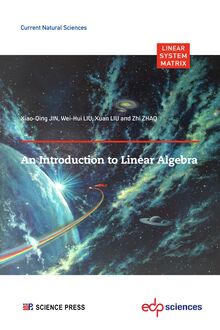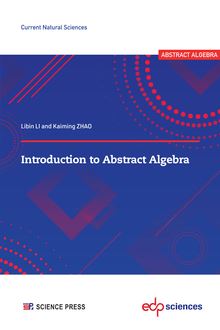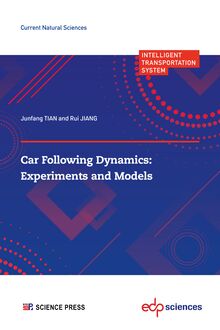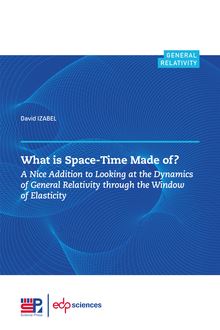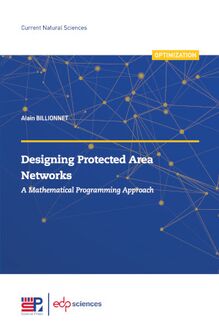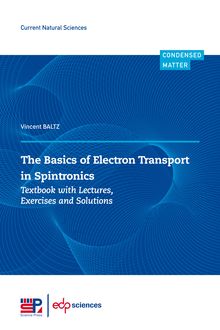Applied Multivariate Statistical Analysis and Related Topics with R , livre ebook
238
pages
English
Ebooks
2021
Obtenez un accès à la bibliothèque pour le consulter en ligne En savoir plus
Découvre YouScribe en t'inscrivant gratuitement
Découvre YouScribe en t'inscrivant gratuitement
238
pages
English
Ebooks
2021
Obtenez un accès à la bibliothèque pour le consulter en ligne En savoir plus
Publié par
Date de parution
22 mars 2021
Nombre de lectures
0
EAN13
9782759826025
Langue
English
Poids de l'ouvrage
86 Mo
Multivariate analysis is a popular area in statistics and data science. This book provides a good balance between conceptual
understanding, key theoretical presentation, and detailed implementation with software R for commonly used multivariate
analysis models and methods in practice.
Publié par
Date de parution
22 mars 2021
Nombre de lectures
0
EAN13
9782759826025
Langue
English
Poids de l'ouvrage
86 Mo
L. WU and J. QIU
Applied Multivariate Statistical Analysis and Related Topics with R
Current Natural Sciences Current Natural Sciences
MULTIVARIATE MULTIVARIATEApplied Multivariate Statistical
ANALYSIS ANALYSIS
Analysis and Related Topics with R
Lang WU and Jin QIU
Multivariate analysis is a popular area in statistics and data
science. This book provides a good balance between conceptual
understanding, key theoretical presentation, and detailed
implementation with software R for commonly used multivariate
Lang WU and Jin QIUanalysis models and methods in practice.
The authors
Lang Wu is Professor of Statistics at the University of British
Columbia in Vancouver, Canada. His research interest includes
the analysis of longitudinal data (or panel data) and survival data
when there are missing values, censored values, measurement
errors, and outliers. Applied Multivariate Statistical
Jin Qiu is Professor of School of Data Sciences at Zhejiang
University of Finance and Economics in Hangzhou, China. Her main Analysis and Related Topics
focus is on multivariate data, longitudinal data (or panel data),
functional data, and spatial data. with R
ISBN : 978-2-7598-2601-8
www.edpsciences.org
Price: XX €L. WU and J. QIU
Applied Multivariate Statistical Analysis and Related Topics with R
Current Natural Sciences Current Natural Sciences
MULTIVARIATE MULTIVARIATEApplied Multivariate Statistical
ANALYSIS ANALYSIS
Analysis and Related Topics with R
Lang WU and Jin QIU
Multivariate analysis is a popular area in statistics and data
science. This book provides a good balance between conceptual
understanding, key theoretical presentation, and detailed
implementation with software R for commonly used multivariate
Lang WU and Jin QIUanalysis models and methods in practice.
The authors
Lang Wu is Professor of Statistics at the University of British
Columbia in Vancouver, Canada. His research interest includes
the analysis of longitudinal data (or panel data) and survival data
when there are missing values, censored values, measurement
errors, and outliers. Applied Multivariate Statistical
Jin Qiu is Professor of School of Data Sciences at Zhejiang
University of Finance and Economics in Hangzhou, China. Her main Analysis and Related Topics
focus is on multivariate data, longitudinal data (or panel data),
functional data, and spatial data. with R
ISBN : 978-2-7598-2601-8
www.edpsciences.orgCurrent Natural Sciences
Lang WU and Jin QIU
Applied Multivariate
Statistical Analysis and
Related Topics with RThis book was originally published by Science Press, © Science Press, 2014.
Printed in France
EDP Sciences – ISBN(print): 978-2-7598-2601-8 – ISBN(ebook): 978-2-7598-2602-5
All rights relative to translation, adaptation and reproduction by any means whatsoever
are reserved, worldwide. In accordance with the terms of paragraphs 2 and 3 of Article
41 of the French Act dated March 11, 1957, “copies or reproductions reserved strictly
for private use and not intended for collective use” and, on the other hand, analyses
and short quotations for example or illustrative purposes, are allowed. Otherwise, “any
representation or reproduction – whether in full or in part – without the consent of
the author or of his successors or assigns, is unlawful” (Article 40, paragraph 1). Any
represenduction, by any means whatsoever, will therefore be deemed an
infringement of copyright punishable under Articles 425 and following of the French
Penal Code.
The printed edition is not for sale in Chinese mainland. Customers in Chinese mainland
please order the print book from Science Press. ISBN of the China edition: Science
Press ISBN: 978-7-03-041243-0
© Science Press, EDP Sciences, 2021Preface
Multivariate analysis models and methods are very useful in data analysis, since
in practice data are often collected on more than one variables and these variables
are often associated or correlated. A main consideration in multivariate analysis
methods is to incorporate the associations or correlations between variables, so
multivariate analysis methods are usually more efficient than univariate analysis methods
which ignore the associations between variables. However, many multivariate analysis
methods are mathematically intractable, so students often get lost in the complicated
mathematical expressions, which prevents them to truly understand the basic ideas
behind many multivariate analysis models and methods. In teaching a multivariate
analysis course for undergraduate or Master level graduate students in statistics, we
believe that the main goal should let students to understand the basic ideas of the
models and methods and then use these models and methods in real data analysis.
Theoretical proofs should be treated as secondary and should be left as exercises
which may help students to better understand the methods and to prepare them for
further studies or research.
A key feature of this textbook is that it focuses on detailed explanations of the basic
ideas of common multivariate analysis models and methods using simple language and
illustrations of the methods using software R. Tedious mathematical derivations are
omitted from the main text and are left in the exercises. With this approach, students
can focus on understanding of the basic ideas without being distracted by tedious
mathematical arguments, as well as applications of the models and methods in data
analysis using software R. Students with strong mathematical background and with
strong interest in further study or research in any topics are encouraged to work on
the theoretical exercises available at the end of each chapter. Moreover, many classic
books on multivariate analysis contain detailed theoretical results, which are listed in
the references, so interested readers can easily assess these materials.
Many books on multivariate analysis focus on inference for multivariate normal
populations, such as parameter estimation and inference for multivariate normal
distributions and normal regression models. This is restrictive since in practice there areii Preface
often discrete or categorical data or skewed data which do not follow normal
distributions. In this textbook, we fill the gaps with chapters on multivariate discrete data,
copula models, and generalized linear models, in addition to standard topics based
on multivariate normal or continuous data. Categorical or discrete data are common
in practice, but this topic often receives little attention in many multivariate
textbooks and undergraduate and graduate curriculums. In this textbook, we provide an
overview of multivariate categorical data analysis, including analysis of contingency
tables and loglinear models. Copula models have received much attention in recent
years, especially in finance. Copula models allow us to build multivariate distributions
from any univariate distributions. Thus they are powerful tools for multivariate
analysis. Generalized linear models allow non-normal response variables so they greatly
extend the applicability of linear regression models.
Results of data analysis can be greatly influenced by noises in the data, such
as missing data, measurement errors, and outliers. For example, in the presence of
missing data, analysis results may be biased or less efficient if the missing data are
simply discarded, and a few outliers in the data may completely change conclusions
from data analysis so the conclusions do not represent population characteristics.
These problems are especially common and bad for multivariate data. However,
these p often receive little attention in many books on multivariate analysis,
so students do not know how to handle these problems in data analysis. In this
textbook, we provide comprehensive discussions of these issues on separate chapters
and offer practical suggestions for data analysts.
This book may be used as a textbook for a multivariate analysis course for
undergraduate and Master-level graduate students in statistics, as well as students or
researchers in other fields who wish to learn basics of multivariate analysis methods
and apply these methods in data analysis. The English language is simpler than
most English textbooks on multivariate analysis, so it is ideal for students whose first
language is not English. Exercises are available at the end of each chapter. These
exercises contain both theoretical problems and data analysis problems. Some of the
theoretical derivations of the methods in the main text are left as exercise problems.
We strongly suggest students to practice these theoretical problems, since such
practice will help students to better understand the models and methods. For the applied
exercise problems, students can follow the procedures explained in the examples and
the R code in the examples. Some materials in certain chapters are challenging, so
they are optional for undergraduate students. At the end of Chapter 1 we providePreface iii
some general advice on good data analysis practice. The datasets and R code in the
book are available at www.stat.ubc.ca/∼lang/text.
We thank many colleagues and students who have provided us useful suggestions
and help. We also thank Zhejiang University of Finance and Economics and School
of Mathematics and Statistics for their supports and encouragements.
Lang Wu and Jin Qiu
Feb. 2014Contents
Preface
......................................................Chapter 1 Introduction 1
.........................................................1.1 Goal of Statistics 1
......................................................1.2 Univariate Analysis 3
....................................................1.3 Multivariate Analysis 7
.......................................1.4 Multivariate Normal Distribution 16
........................1.5 Unsupervised Learning and Supervised Learning 21
.......................1.6 Data Analysis Strategies and Statistical Thinking 23
..............................................

